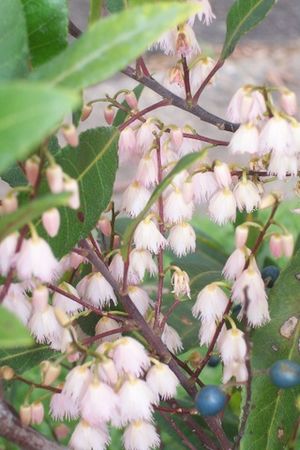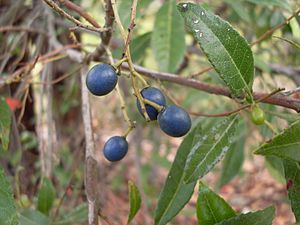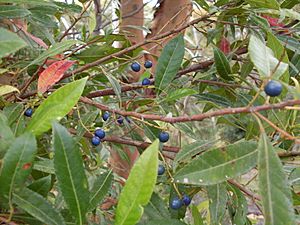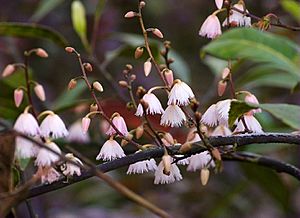Blueberry ash facts for kids
Quick facts for kids Blueberry ash |
|
|---|---|
 |
|
| Flowers and fruit | |
| Scientific classification | |
| Genus: |
Elaeocarpus
|
| Species: |
reticulatus
|
| Synonyms | |
The Blueberry Ash (scientific name: Elaeocarpus reticulatus) is a special tree that grows only in Australia. You can find it all along the east coast, from Fraser Island, Queensland, down to Flinders Island, Tasmania. People also call it by other fun names like "fairy petticoats" or "lily of the valley tree" because of its pretty flowers.
The fruit of the Blueberry Ash has an outer skin and a soft inner part that you can eat. Australian Aboriginal people have used it for things like "bush tucker tea" and even jam. The fruit has a big, hard seed inside. Even though they look like berries, botanists (plant scientists) call them "drupes" – like a peach or an olive. This tree is great for attracting wildlife such as bees, birds, and butterflies.
Contents
What Does the Blueberry Ash Look Like?
This evergreen tree can grow from 3 to 15 meters (about 10 to 50 feet) tall and 1 to 5 meters (about 3 to 16 feet) wide. In some Rainforests in New South Wales or Queensland, it can even reach 30 meters (nearly 100 feet) if the conditions are just right.
One of the most noticeable things about this tree is its many white or sometimes pinkish cup-shaped flowers. They have fringed edges and hang downwards, looking like tiny skirts. Another beautiful feature is the round-oval fruits. These fruits are a stunning bright blue, and if you look closely, you'll see tiny yellowish-white spots on their smooth surface. They look like small olives, about 1 centimeter (less than half an inch) long.
The leaves are tough and can be up to 12 centimeters (about 5 inches) long. They are shaped like a spear with a pointed tip and have jagged edges. Some leaves have a thin, whitish layer on them, almost like evaporated salt. As the leaves get older, they turn a bright red while still on the tree. This creates a lovely color contrast with the dark green leaves. When the tree is trimmed, new leaves often grow with an attractive pink color.
Where Does the Blueberry Ash Grow?
This tough plant is native to eastern Australia. It can grow in many different conditions, but it prefers warmer temperate climates along the coast. It originally comes from rainforest-like areas. You can find it in southeastern Queensland, eastern New South Wales, and on Flinders Island in Tasmania. However, it has also adapted to drier parts of southeastern Australia. In New South Wales, it grows in moist places like gullies and near water, as well as in tall Eucalyptus forests and sandy coastal areas.
How Is Blueberry Ash Used?
A Great Tree for Wildlife
The name Blueberry Ash comes from its pretty blue fruits. These fruits attract many birds, like the Regent bowerbird, which collects them because of their blue color. Other birds that enjoy these fruits include Wonga Pigeons, Crimson Rosellas, Figbirds, White Headed Pigeons, and Olive-backed Orioles. This tree is excellent for helping natural areas grow back and for supporting local wildlife.
Food and Growing
The Blueberry Ash is known as a "bush tucker" plant. This means its berries can be eaten. You can eat the berries fresh, or crush them to make jam. Birds also love these berries, making them an important part of their diet.
It can be tricky to grow this tree from its hard seeds. One way to help new trees grow is by letting birds eat the fruit. Then, the seeds that pass through the birds can be collected and used for planting.
Fire Safety
The Blueberry Ash is considered a fire retardant plant. This means it doesn't catch fire easily in a moderate bushfire. If it does catch fire during a big bushfire, it will burn slower than many other plants.
However, if a Blueberry Ash tree burns, it usually cannot grow back from its side shoots. It has to regrow from seeds that are already in the soil or from new seeds brought to the area by birds. Other related species also struggle to recover from fire.
Gallery
- You can find more details about this tree's size and look on these websites:
- PlantNET New South Wales Flora Online: Elaeocarpus reticulatus
- reticulatus.htm Lucidcentral: Elaeocarpus reticulatus
Images for kids
-
Habit in Kanangra-Boyd National Park
See also
 In Spanish: Fresno arándano para niños
In Spanish: Fresno arándano para niños






